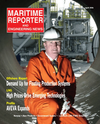
Page 45: of Maritime Reporter Magazine (April 2006)
The Offshore Industry Annual
Read this page in Pdf, Flash or Html5 edition of April 2006 Maritime Reporter Magazine
April 2006 45
The trend of the past few years towards an ever smaller Norwegian for- eign going fleet, measured in dwt, has continued through the whole of 2005, according to the Norwegian Shipowner
Associations most recent quarterly report. On January 1, 2006, the fleet totalled 37.1 million dwt. This was a decline of 0.6 million dwt since October 1. From January 1, 2005 the fleet has decreased by 3.8 million dwt (9.3 per- cent). The decline in the tonnage in the
NIS-register was 12 percent over the past four quarters, however, throughout the last quarter of 2005 the tonnage in
NIS only declined marginally.
While overall tonnage is on the decline, the picture is rosier in regards to the number of ships. During the fourth quarter of 2005 the number of ships in the Norwegian fleet increased by 22 to a total of 1,642. Over the past 12 months, the fleet increased by 28 ships. Over the past few years there has been an increased concentration on offshore service vessels. While the ships are small in tonnage, they are technically advanced and quite expensive.
Fifty-three percent of the ships in the foreign going fleet are now flying the
Norwegian flag. This is a decline of four percentage points from a year earlier, continuing a trend that has persisted for some years. The number of Norwegian mobile offshore units increased by one to 57 during the fourth quarter of 2005.
On January 1, 2006 the fleet consisted of 26 semi-submersibles, 14 floating production vessels, 10 tenders, 5 drill- ships and two jack-ups.
The high oil price continues to stimu- late the activity both on the Norwegian shelf and in other offshore areas. If the oil price remains as high as the market for forward oil contracts suggests, the activity will probably increase further and remain high for several years. As of
January 1, 2006 eight units were inac- tive - six of them undergoing mainte- nance or upgrading. One year earlier the number inactive was eight, including five that were laid up. The utilization rate for the Norwegian fleet was 86 per- cent as of January 1, 2006, while the corresponding utilization rate for the world fleet was 91 percent. Of the 49 active Norwegian mobile offshore units, 14 (29 percent) were employed on the
Norwegian shelf; 11 (23 percent) were working offshore Africa; nine (18 per- cent) worked off Asia; seven (14 per- cent) worked in the U.K, sector, and the same number were in American waters.
One worked outside Australia.
Building orders of ships for
Norwegian account increased by 28 dur- ing the fourth quarter of 2005 to 212.
Over the past four quarters the increase is 42 percent. In addition 20 mobile off- shore units were on order as of January 1, an increase of one during the fourth quarter, and as much as 15 over the past four quarters. On January 1, Norwegian orders for mobile offshore units amount- ed to about one third of the world's order book. The largest category in number of ships on order was offshore service ves- sels, with 79 (67 as of October 1 2005).
The other categories of ships on order are 40 chemical tankers (35), 29 gas tankers (21), 26 other dry cargo ships (26), 18 oil tankers (15), 15 bulk carriers (17), and five passenger vessels (3).
Circle 208 on Reader Service Card
Norway
Norway Ships: Offshore Activity Drives Business
MR APRIL2006 #6 (41-48).qxd 4/3/2006 1:55 PM Page 45

 44
44

 46
46
